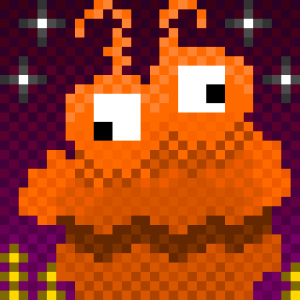
‘@Play‘ is a frequently-appearing column which discusses the history, present, and future of the roguelike dungeon exploring genre.
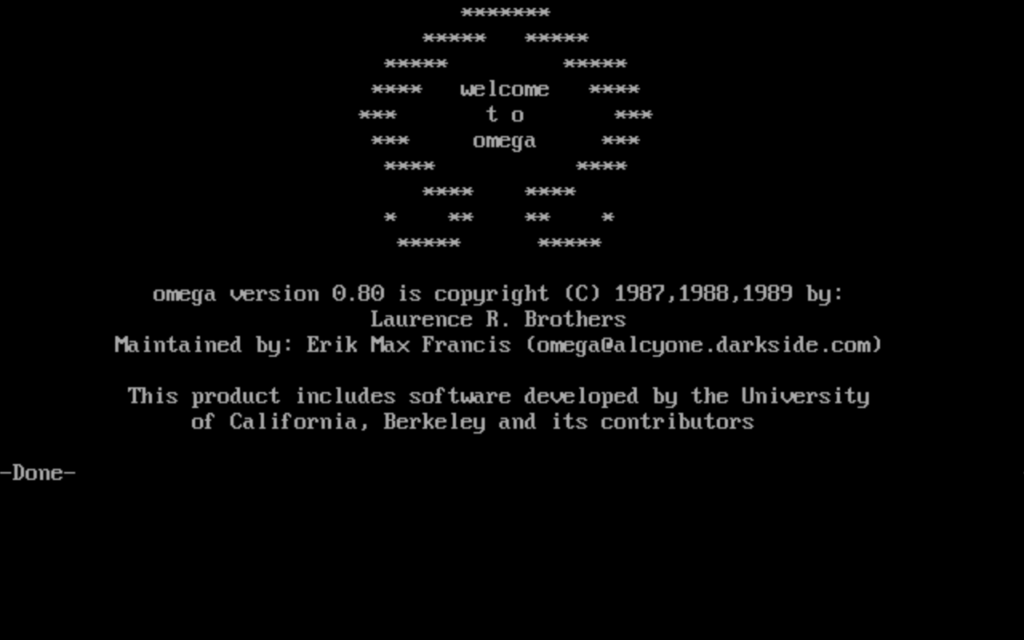
This is the beginning of our exploration of classic roguelike Omega. Instead of opening with a mere explication of the game and its history, I figured I’d offer some play examples through screenshots, and give a bit of the story of my experience with it, while explaining some of the points of the game’s beginning along the way. After all, my aim is to get you interested in this game, maybe even to try it out yourself, and a mere description of it is unlikely to push you very far in that direction.
A more detailed description of the game is coming soon-tomorrow, in fact. In the meantime, this short play was under version 0.80.2, which is the current “stable” version, and has been for over 20 years. There is a newer “development” version, 0.90.4, which is almost as old.
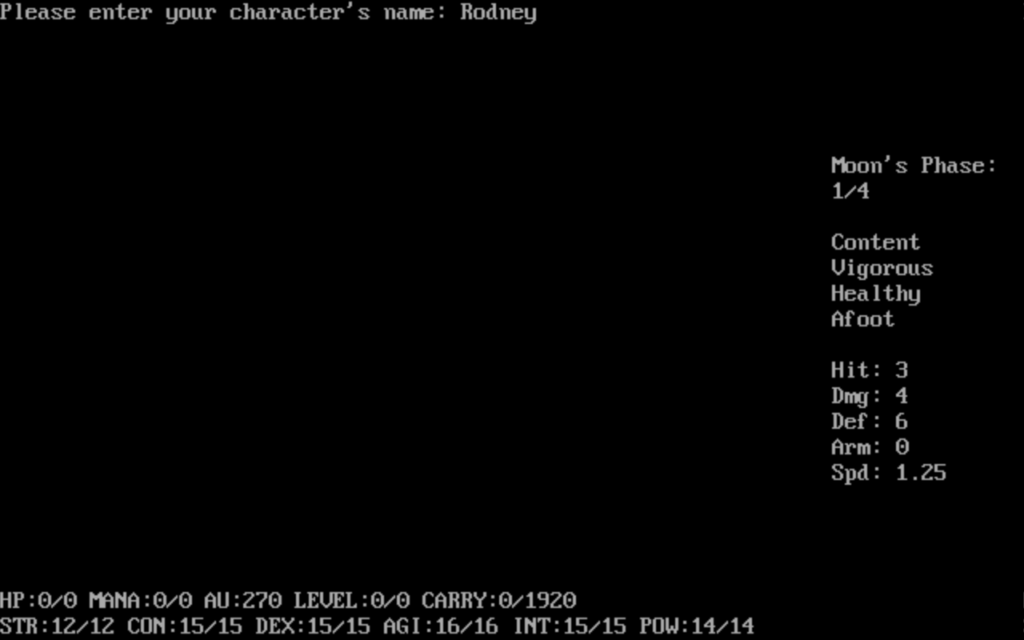
So, I started a new game of Omega. Starting characters are rated on the traditional D&D scale of 3 to 18, though they can become higher during play. A few rerolls resulted in stats that were above average across the board. While the highest was only 16, none was beneath 12. I accepted them and named the character Rodney. (It’s a lucky name. Bad luck.)
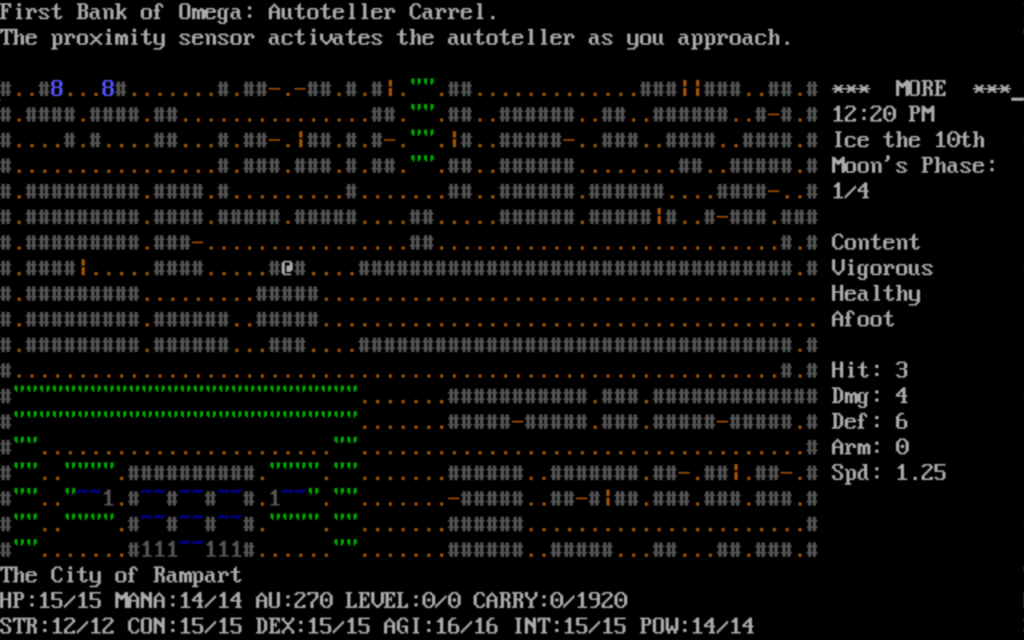
All games of Omega begin in Rampart. The layout of the city doesn’t change generally, but the location of some businesses and places does, as does the layout of its hedge maze. Rampart is safe to rest in, unless you gain the ire of monsters in the hedge maze. They won’t come out to bother you unless you go inside and they see you.
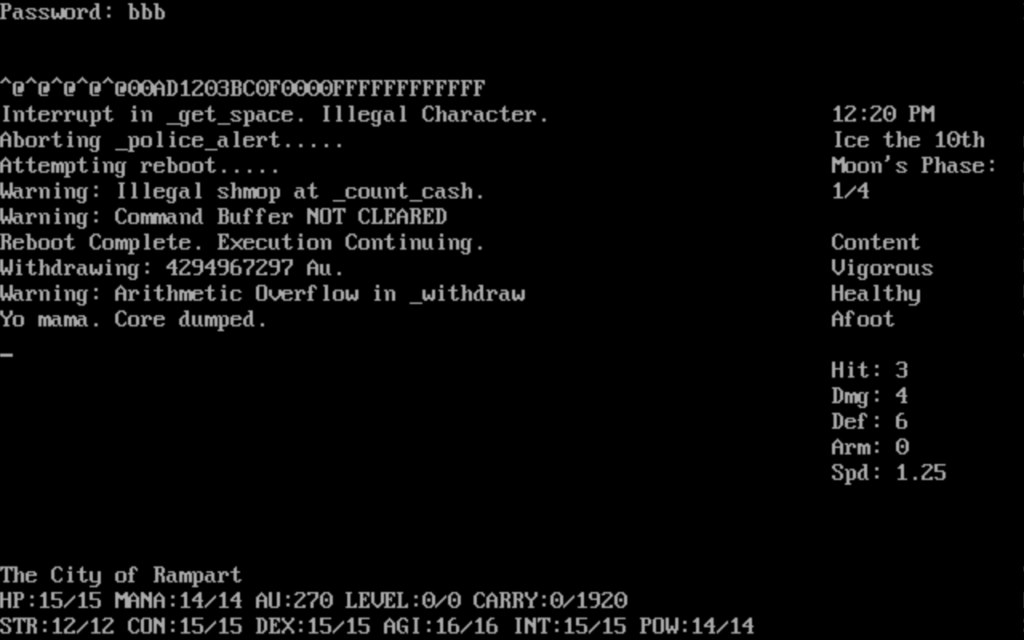
I decided to go for a chaotic build this time, which meant not being able to avail myself of the many benefits of Paladin-hood, but allowing my character to worship Set, who grants the spell of Invisibility when joining. Invisibility is helpful for escaping inopportune battle. It also means I can go ahead and rob the ATM right away instead of waiting until after joining up with the Paladins or a lawful religion.
This is a spoiler, but it’s one of the most-used plays in Omega, and it greatly helps you get characters underway. To rob the ATM, open an account (press Shift-O while interacting with it), choose a password, then press Shift-P and enter a different password than you entered. The ATM will tell you the police have been called an to “Press space to continue.” Press any key other than space. There’ll be a little display and you’ll end up with between 1,000 and 4,000 more gold. This will break the ATM, so you can’t do it again, and give you a bit of Chaotic alignment, but it’s not much and you can get it reduced easily by talking to the Archdruid, which you should do really soon anyway.
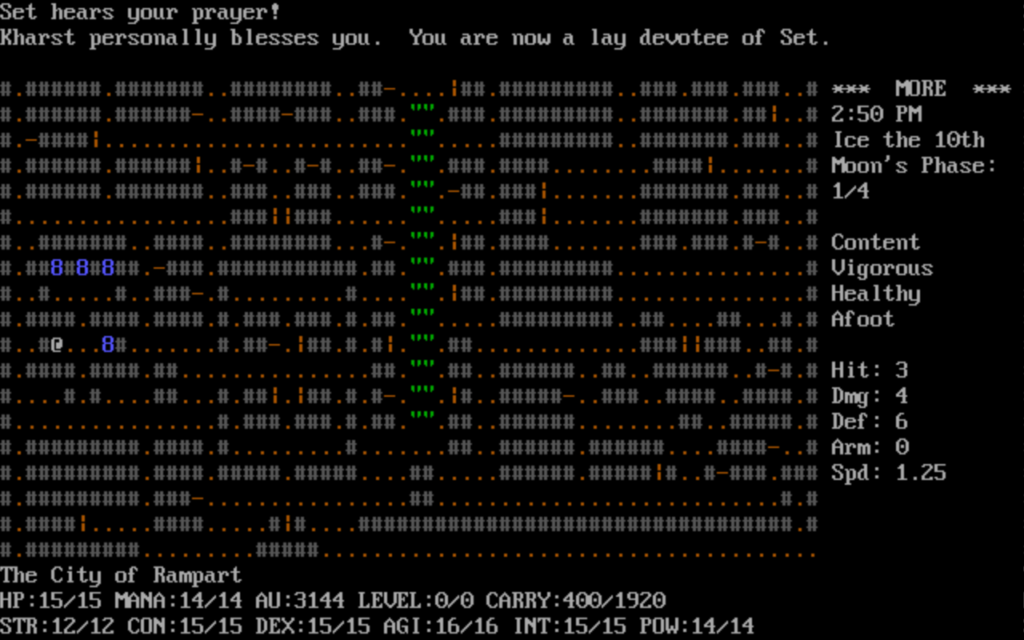
The ATM money is important for joining one of the magic guilds and the Thieves’ Guild, which are very expensive to a starting character, and help you pick up some bargains from the city Pawn Shop. My exploration of the city found the Thieves’ Guild in the upper-right corner of the city. I joined up with three guilds: the Collegium Magii, the religion of Set, and the Thieves’ Guild.
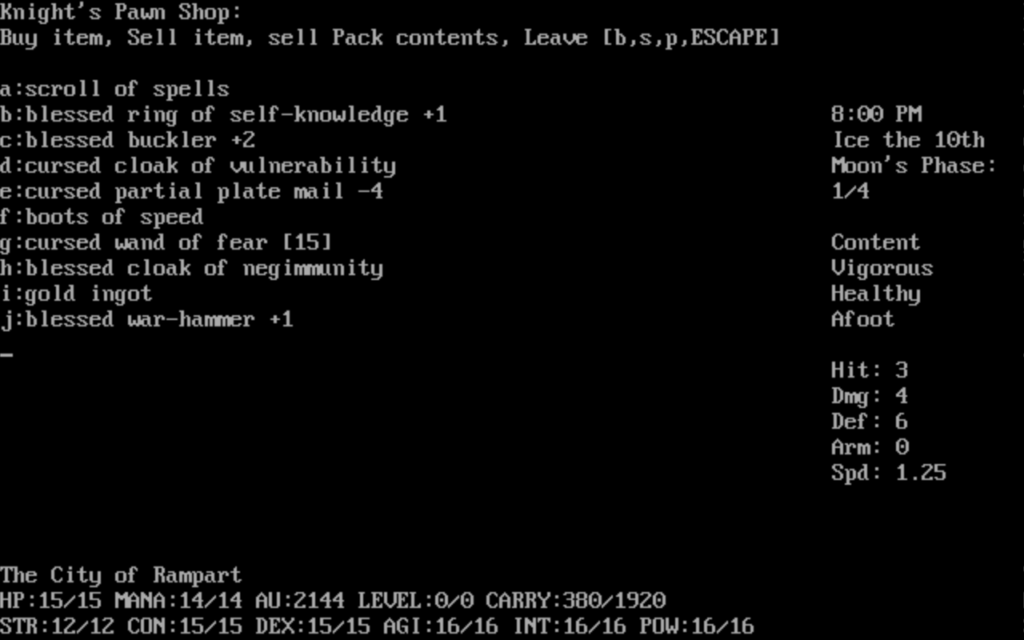
The Pawn Shop often sells useful random items, and its stock slowly changes as time passes. In this game its starting inventory included boots of speed, a terrific item that can make the early game much easier. It also had a scroll of spells. Reading a scroll of spells provides a chance of learning a random spell, which can also greatly improve a character’s viability. Sadly, this one provided nothing.
Having higher Dexterity, I decided to go with light weapons. The choice in Omega is generally between heavy bladed and crushing weapons, which use Strength, or light and missile weapons, which rely on Dexterity. I went with an epee, costing 100 gold, which turned out to be a great choice for this character.
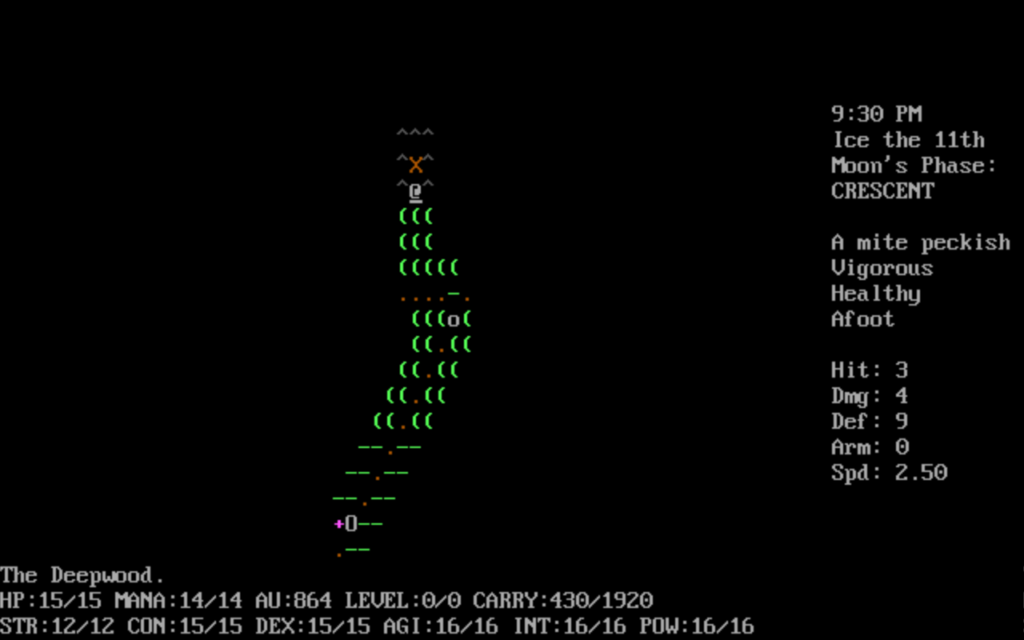
Rodney’s various career tracks now underway, they visited “Commandant Sonder’s Rampart-Fried Lyzzard Partes” and bought 20 buckets (it’s easy to run out of food in the wilderness), and then stepped out of town for a stroll north to see the Archdruid. A chat with the Archdruid provides 250 experience points, enough to immediately advance a character to Level 3. A Level 3 character is far from omnipotent, but won’t be in danger of being fried by a cosmic ray, which happens in Omega from time to time. You can also get your alignment neutralized somewhat there, but I was leaning into Chaoticness.
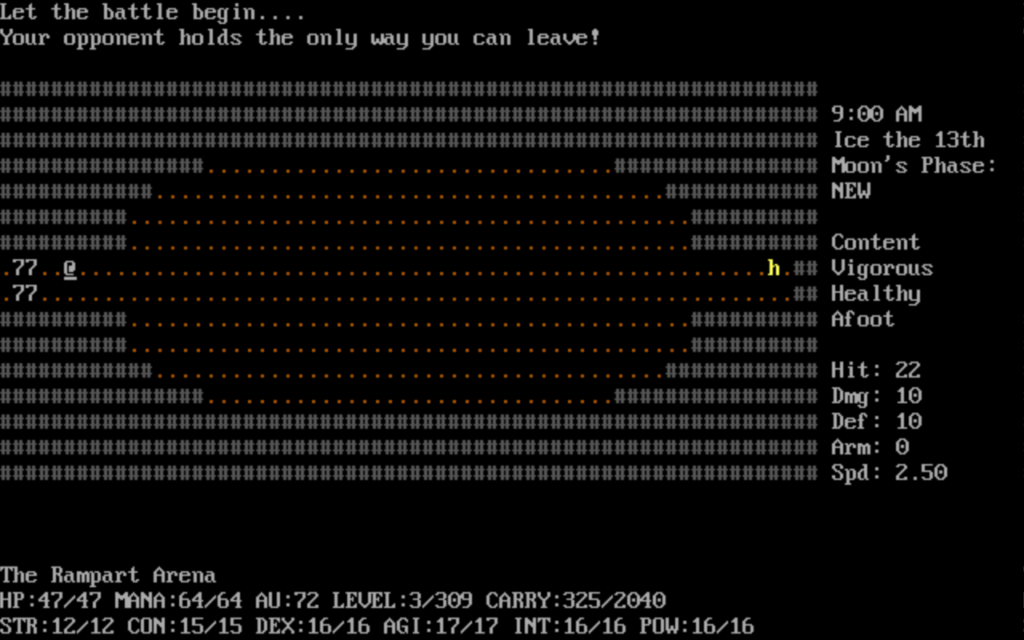
Back in Rampart. A place to get a few extra gold pieces is fighting the first opponents in the arena, which is usually pretty safe if you restrict yourself to the first four. (Note, if you join the Gladiator guild, you’ll earn more money for your fights, but will also be advanced to harder opponents!)
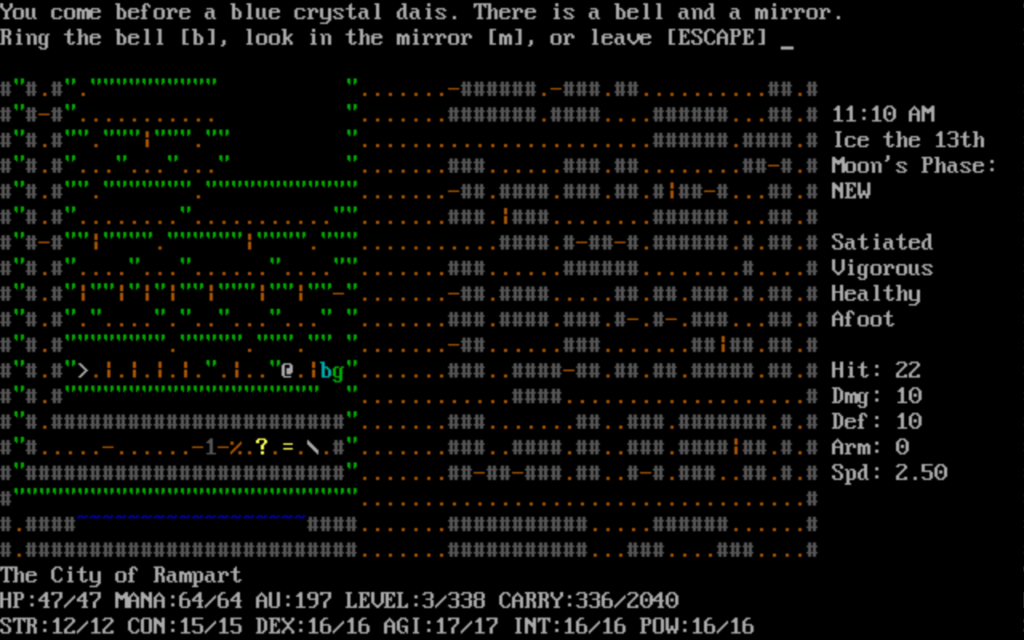
There’s a general sequence of events in Omega’s early game that provides for optimal play. After robbing the ATM and advancing to level 3, I usually like to tackle the hedge maze. At level 3 the opponents here are usually not too bad, although there’s always the danger of encountering something hideously strong: I once got roasted here by a fire-breathing salamander. The traps here can also be dangerous for the unwary.
One reason for exploring the hedge maze is to get access to the Oracle, who eventually provides access to an important late-game location, but also gives advice on where to go and can reveal your alignment to you. When the game asks if you want to attack them, be sure to say No! You may also find a few random items and the entrance to the Sewers, an early dungeon.
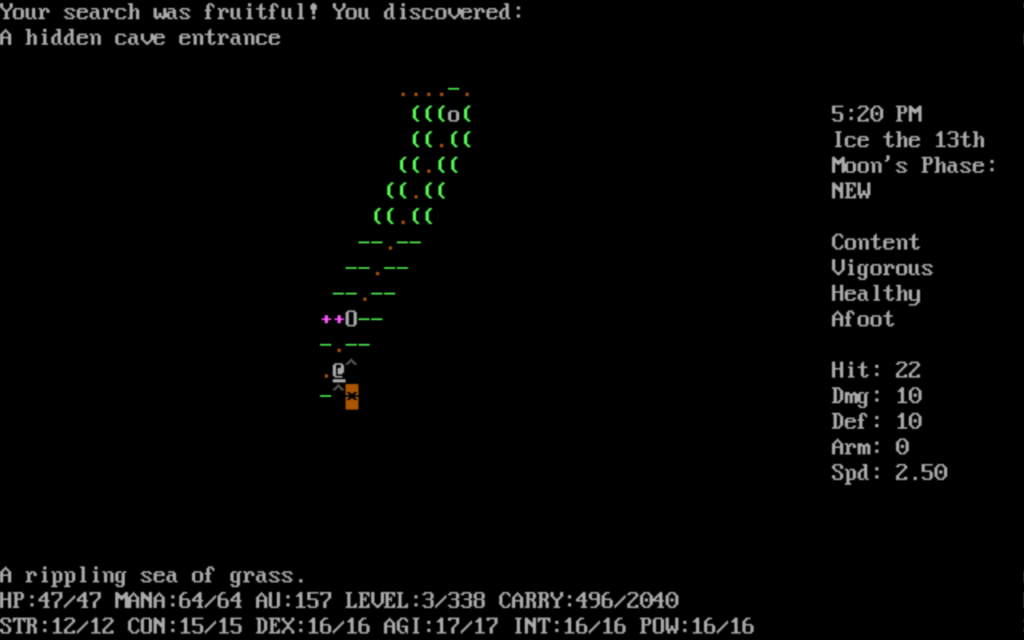
Then it’s off to the Duke of Rampart to get the first quest, which involved killing the Goblin King. The Duke will only deign speak with you if you’re at least Level 3. Outside town, the Goblin Caves must be searched for in the wilderness, with the ‘s’ key, but are always in the same place: three spaces south of the city.
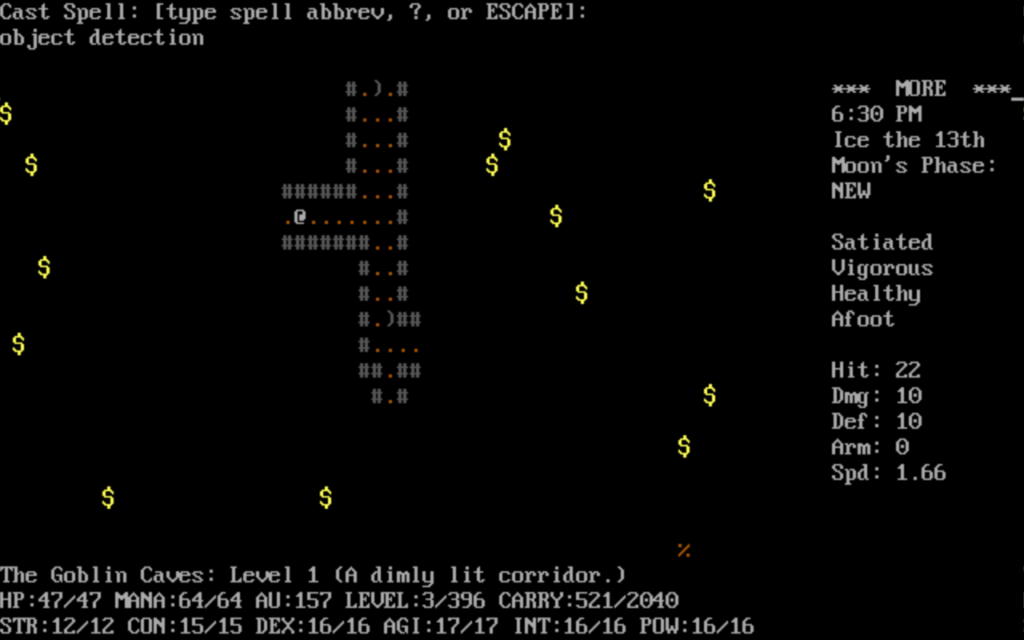
Here we see the result of casting Object Detection. It’s cheap to cast, and can provide aid in determining which passages to explore in dungeons. But mana points in Omega don’t naturally regenerate over time, only from gaining an experience level or other explicit sources, and so must be guarded jealously. One of the more horrible things that can happen to a magic-using Omegan is stepping on a Manadrain Trap, which can leave you helpless. If you’re not in the Sorcerers’ Guild they charge a ton of cash to refill your mana. It’s worth looking out for powtabs in the pawn shop, which restore mana when eaten.
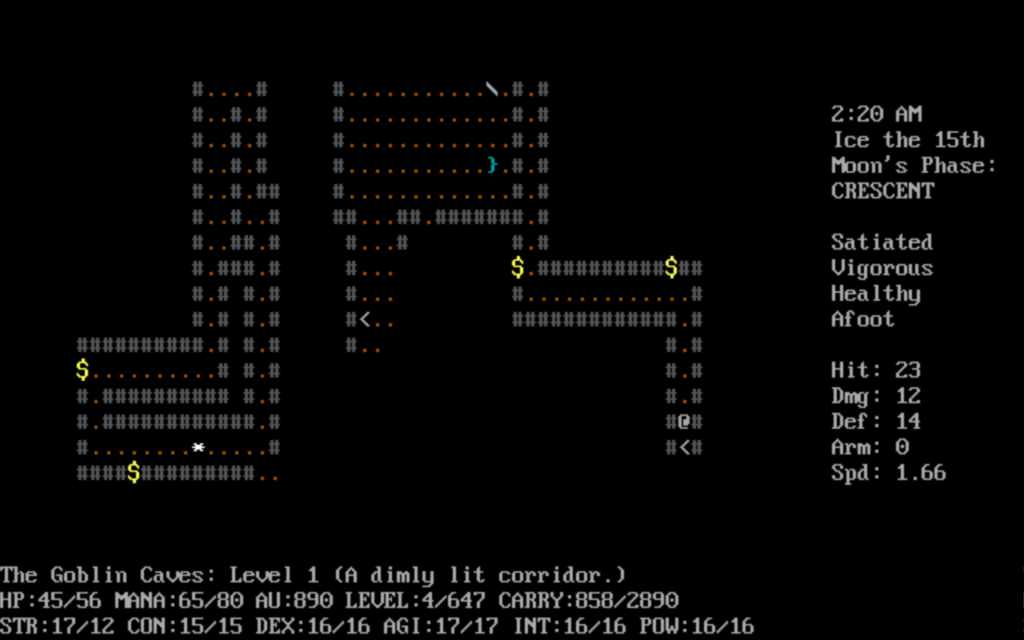
The Goblin Caves have a winding kind of structure, and often have copper pieces embedded in the wall. You can tear down many walls by using the Tunnel command (shift ‘T’), but this produces a pile of rubble that harms you when you wade through it, and that takes time to dig yourself out of. It’s mostly useful for getting yourself out of passages where you’re trapped by neutral NPCs who block you and refuse to get out of your way. (Or you could just kill them, if you’re of chaotic bent.)
As you gain character experience, you also advance in all the guilds you’re a member of. The guilds provide extra benefits as you gain standing with them; the Collegium Magii teaches you the Identification spell, although if you’re a member of the Thieves’ Guild, item ID is pretty cheap there.
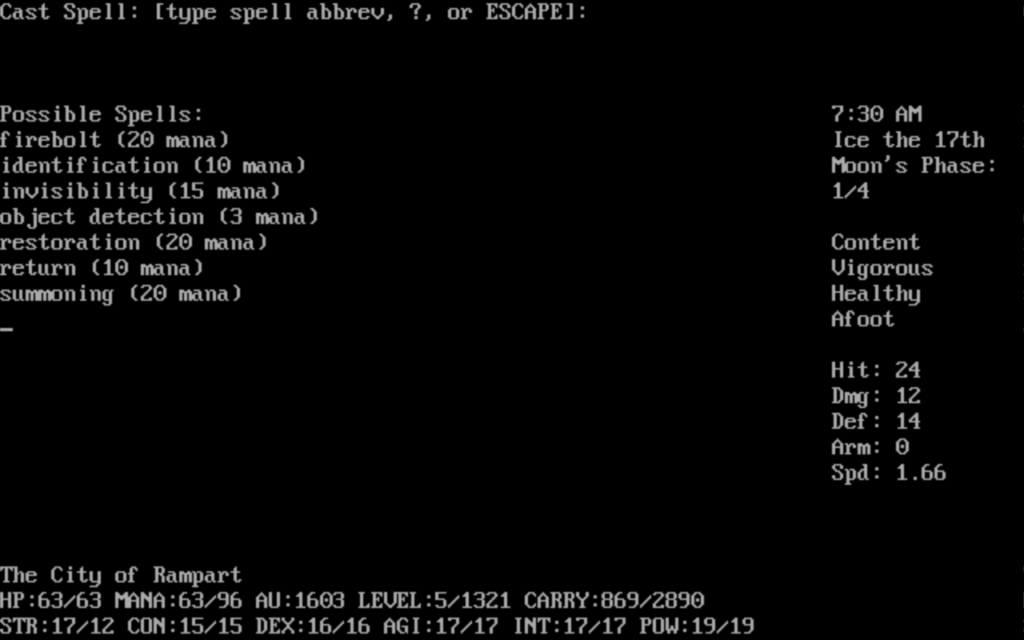
Advancing in a religion is a good source of spells. Several of these spells came from worshiping Set. I currently know only one combat spell: Firebolt. It isn’t bad, although it’s costly to cast.
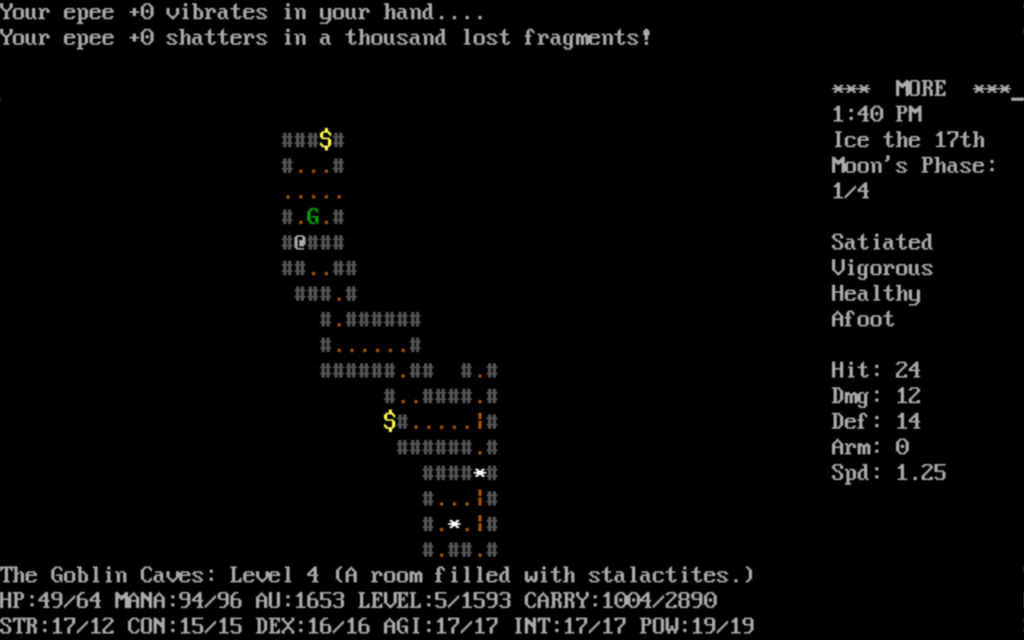
Here’s an instance of some of that bad luck I mentioned! If you fail an attack particularly badly in combat, you may drop your weapon, or it may even break! This kind of tragic happenstance is all over the place in Omega. You just have to roll with it. If all you have is your hands you’re useless in a fight with ! It can be worth it to carry a spare in your pack.
A good test of whether your character is doing well is if you can easily defeat the chieftains in the Goblin Caves. A Goblin Chieftain is fast, and hits hard with their great axes. If you’re wielding a weapon not indicated by your stats they’ll put an end to your adventure very quickly.
While Goblin Chieftains are bad, Goblin Shamans, which look identical on the screen (a green G) are even worse! They can cast a variety of annoying spells, and can poison you, give you a disease (get this cured at the Healer’s in town) or even put you to sleep. That last one nearly ended the game by itself.
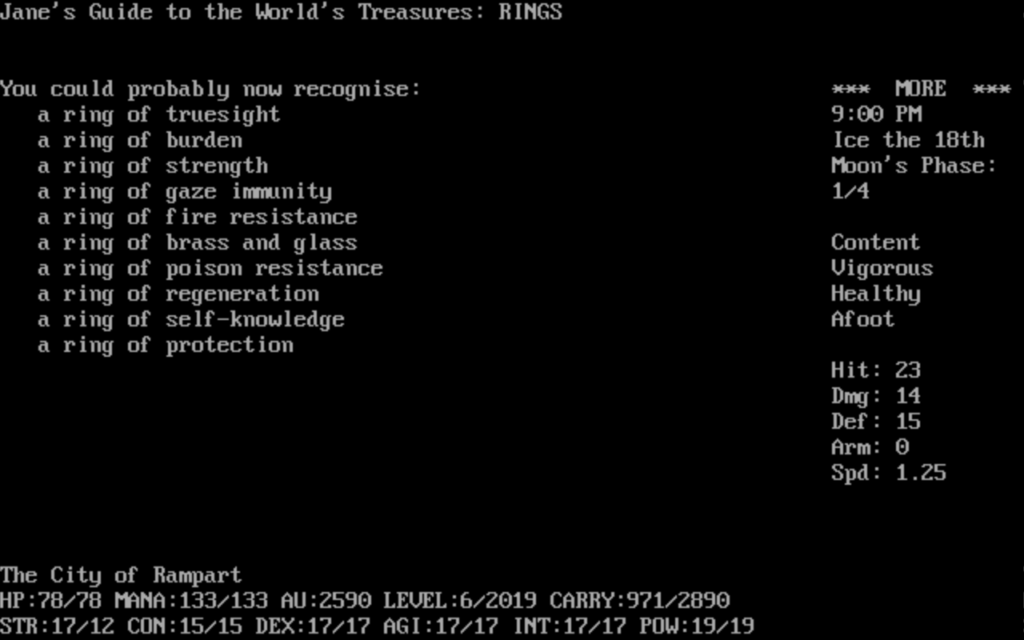
There’s identification scrolls and spells in Omega, and you can pay the Thieves’ Guild to identify things you’re carrying, but there are also random scrolls that outright identify an entire category of item. These are all identified as “Jane’s Guide to Treasure,” and they’re definitely worth purchasing if you find one in the Pawn Shop.
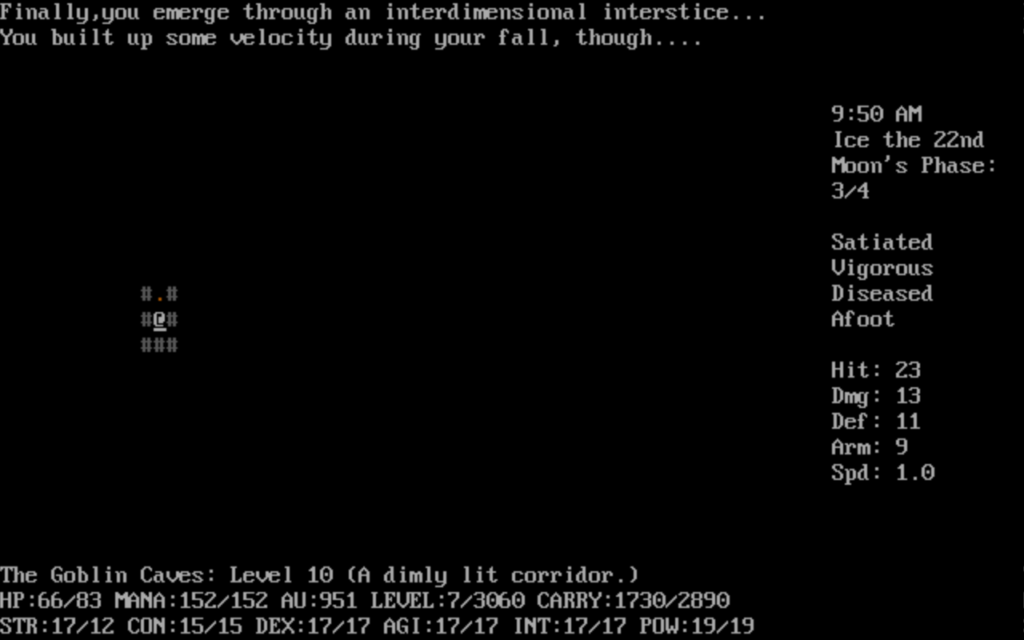
Some traps in the dungeons are particularly nasty. Abyss Traps can teleport you to a random location, and also tack on some damage too. I already mentioned how dangerous Manadrain Traps can be to a magic user. Disintegration Traps can annihilate a piece of equipment you’re wearing. The choices are either to search every space (and even that might not be enough) or hope for the best. If your Dexterity is pretty good, it’s usually not hard to disarm known trips with Shift-D.
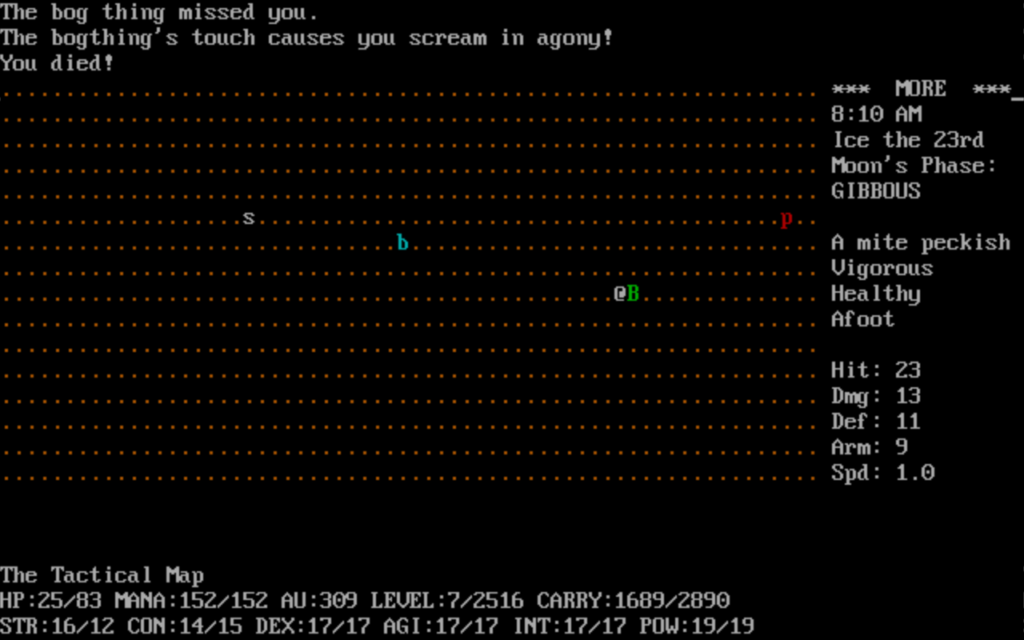
It was a pretty good game, but it ultimately ended at the hands of a bog thing in the wilderness. Turns out they’re pretty tough. Who knew? Omega is of the school of game that teaches primarily by killing you over and over again. Each new monster is a fresh opportunity to possibly get slaughtered because you don’t know if it’s too strong for you to tackle, or the special trick to beating it.
Maybe that’s a good indication of what playing Omega is like? I have elided a lot. Tune in tomorrow for a more traditional introduction to Omega.

